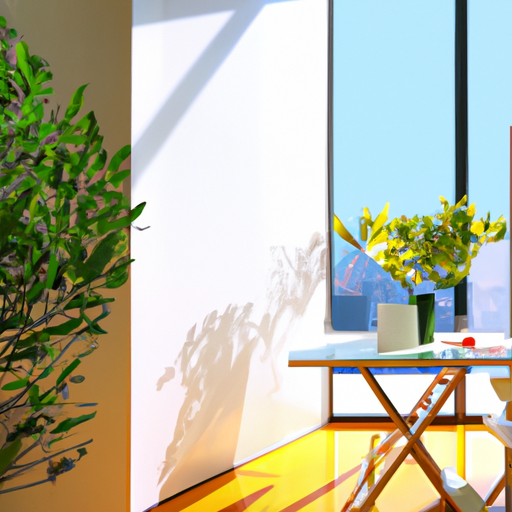Balancing Aesthetics and Functionality: Key Architectural Elements for a Comfortable Home
The role of architecture in creating a comfortable home cannot be overstated. A well-designed home not only provides a sense of security and belonging but also enhances the quality of life for its inhabitants. Balancing aesthetics and functionality is a crucial aspect of architectural design, as it ensures that a home is not only visually appealing but also practical and comfortable to live in. This article will discuss some key architectural elements that contribute to creating a comfortable home, focusing on the delicate balance between aesthetics and functionality.
One of the most important aspects of a comfortable home is the efficient use of space. A well-designed floor plan ensures that every square foot is utilized effectively, providing ample room for movement and daily activities. This involves creating a logical flow between different areas of the home, such as the living room, kitchen, and bedrooms. Open floor plans have become increasingly popular in recent years, as they promote a sense of spaciousness and allow for greater flexibility in furniture arrangement. However, it is essential to strike a balance between openness and privacy, ensuring that each room serves its intended purpose without feeling too exposed or cramped.
Another key architectural element in creating a comfortable home is the incorporation of natural light. Ample daylight not only reduces the need for artificial lighting but also has a significant impact on the overall ambiance and mood of a space. Large windows, skylights, and glass doors can help maximize natural light, creating a bright and welcoming atmosphere. Additionally, the strategic placement of windows can also promote cross-ventilation, improving indoor air quality and reducing the reliance on air conditioning systems. It is essential to consider the orientation of the home and the surrounding environment when designing window placements, as this can greatly influence the amount of sunlight and heat entering the space.
The choice of materials also plays a significant role in balancing aesthetics and functionality in a comfortable home. Durable and low-maintenance materials are ideal for busy households, as they can withstand daily wear and tear without compromising on appearance. For instance, hardwood floors are not only visually appealing but also highly resilient and easy to clean. Similarly, the use of natural materials such as stone and wood can add warmth and texture to a space, creating a cozy and inviting atmosphere. It is essential to consider the local climate and environmental factors when selecting materials, as this can greatly impact the longevity and performance of the home.
In addition to the physical aspects of architectural design, the integration of technology can also contribute to a comfortable home. Smart home systems, such as automated lighting, heating, and security, can greatly enhance the convenience and functionality of a space. These systems can be customized to suit individual preferences and needs, ensuring that the home is tailored to the unique requirements of its inhabitants.
In conclusion, the role of architecture in creating a comfortable home is multifaceted, encompassing various elements such as efficient space planning, natural light, material selection, and technological integration. By striking a balance between aesthetics and functionality, architects can design homes that not only look beautiful but also provide a comfortable and practical living environment. Ultimately, a well-designed home has the power to improve the quality of life for its inhabitants, making the pursuit of architectural excellence a worthwhile endeavor.
The Impact of Natural Light and Ventilation on Home Comfort and Well-being

The role of architecture in creating a comfortable home cannot be overstated. A well-designed home not only provides shelter and security but also enhances the well-being of its occupants. One of the most significant aspects of architectural design that contributes to a comfortable living environment is the incorporation of natural light and ventilation. This article will explore the impact of these elements on home comfort and well-being, and how architects can optimize their designs to create spaces that are both functional and enjoyable to live in.
Natural light is a crucial component of a comfortable home. It has been proven that exposure to natural light has numerous health benefits, including improving mood, boosting energy levels, and regulating sleep patterns. Furthermore, natural light can make a space feel more open and inviting, which can contribute to a sense of well-being. Architects can maximize the amount of natural light in a home by carefully considering the orientation of the building, the size and placement of windows, and the use of reflective surfaces to bounce light deeper into the interior spaces.
The orientation of a building plays a significant role in determining the amount of natural light that enters the home. In general, north-facing windows provide consistent, indirect light throughout the day, while south-facing windows allow for more direct sunlight. East and west-facing windows can provide ample morning and afternoon light, respectively, but may also result in glare and overheating during certain times of the day. By taking these factors into account, architects can design homes that receive an optimal amount of natural light throughout the day.
The size and placement of windows also have a significant impact on the amount of natural light that enters a home. Large windows, particularly those that extend from floor to ceiling, can flood a space with light and create a strong connection between the interior and exterior environments. However, it is essential to balance the desire for large windows with the need for privacy and energy efficiency. Strategically placing windows to capture the best views and light while minimizing heat loss and unwanted solar gain is a critical aspect of architectural design.
Reflective surfaces can also be used to enhance the amount of natural light in a home. Light-colored walls, ceilings, and floors can help bounce light deeper into interior spaces, reducing the need for artificial lighting and creating a more pleasant atmosphere. Mirrors and other reflective surfaces can also be strategically placed to direct light into darker areas of the home.
In addition to natural light, proper ventilation is essential for creating a comfortable home environment. Good ventilation helps to maintain indoor air quality by removing pollutants, moisture, and odors, and can also help to regulate temperature and humidity levels. Architects can design homes with effective ventilation by incorporating features such as operable windows, vents, and skylights, as well as considering the placement of doors and interior partitions to encourage air circulation.
Cross-ventilation, which occurs when air flows through a space from one side to the other, is an effective way to promote natural ventilation in a home. This can be achieved by placing windows and doors on opposite sides of a room or by using interior partitions to direct airflow. Additionally, stack ventilation, which relies on the principle that hot air rises, can be used to draw fresh air into a space through lower openings and expel warm air through higher openings, such as skylights or vents.
In conclusion, the role of architecture in creating a comfortable home is multifaceted, with natural light and ventilation being key components of a well-designed living environment. By carefully considering the orientation of a building, the size and placement of windows, and the use of reflective surfaces, architects can create homes that are not only aesthetically pleasing but also contribute to the well-being of their occupants. Furthermore, incorporating effective ventilation strategies can help to maintain indoor air quality and create a comfortable living environment that promotes health and happiness.
Integrating Indoor and Outdoor Spaces: Architectural Techniques for a Seamless Living Experience
The role of architecture in creating a comfortable home cannot be overstated. A well-designed home not only provides shelter and security but also enhances the quality of life for its inhabitants. One of the key aspects of a comfortable home is the seamless integration of indoor and outdoor spaces. This integration not only expands the living area but also allows for a more harmonious connection with nature, promoting a sense of well-being and relaxation. In this article, we will explore various architectural techniques that can be employed to create a seamless living experience by integrating indoor and outdoor spaces.
One of the most effective ways to integrate indoor and outdoor spaces is through the use of large windows and glass doors. These elements not only allow for an abundance of natural light to enter the home but also create a visual connection between the interior and exterior spaces. By blurring the boundaries between inside and outside, large windows and glass doors can make a home feel more spacious and inviting. Additionally, they can also improve energy efficiency by reducing the need for artificial lighting during the day.
Another architectural technique that can be employed to create a seamless living experience is the use of open floor plans. Open floor plans eliminate the need for walls and doors between different living areas, allowing for a more fluid and connected living space. This design approach not only makes a home feel larger but also encourages social interaction among family members and guests. Furthermore, open floor plans can be combined with outdoor living spaces, such as patios and decks, to create a continuous flow between indoor and outdoor areas.
Incorporating transitional spaces, such as screened porches, sunrooms, and covered patios, is another effective way to integrate indoor and outdoor spaces. These spaces act as a bridge between the interior and exterior of a home, providing a comfortable and protected area where inhabitants can enjoy the outdoors without being exposed to the elements. Transitional spaces can be designed to accommodate various activities, such as dining, lounging, or even working, making them a versatile addition to any home.
The use of consistent materials and design elements both inside and outside the home can also contribute to a seamless living experience. By using similar flooring materials, wall finishes, and architectural details in both indoor and outdoor spaces, a sense of continuity and cohesion can be achieved. This design approach not only creates a visually pleasing aesthetic but also reinforces the connection between the interior and exterior of a home.
Landscaping plays a crucial role in integrating indoor and outdoor spaces as well. A well-designed landscape can extend the living area of a home by creating inviting outdoor spaces that complement the interior design. Incorporating elements such as water features, outdoor fireplaces, and comfortable seating areas can create a welcoming environment that encourages inhabitants to spend more time outdoors. Additionally, the use of plants and trees can help to soften the transition between indoor and outdoor spaces, providing a natural and organic connection between the two.
In conclusion, the integration of indoor and outdoor spaces is an essential aspect of creating a comfortable home. By employing architectural techniques such as large windows and glass doors, open floor plans, transitional spaces, consistent materials and design elements, and thoughtful landscaping, a seamless living experience can be achieved. This not only enhances the quality of life for the inhabitants but also contributes to a more sustainable and energy-efficient home. As our understanding of the relationship between architecture and well-being continues to evolve, the importance of creating harmonious and connected living spaces will only become more apparent.
Q&A
Question 1: How does architecture contribute to creating a comfortable home?
Answer 1: Architecture plays a crucial role in creating a comfortable home by focusing on aspects such as space planning, natural lighting, ventilation, and materials. These elements ensure that the home is functional, energy-efficient, and aesthetically pleasing, ultimately providing a comfortable living environment for the occupants.
Question 2: What architectural features can improve the comfort of a home?
Answer 2: Architectural features that can improve the comfort of a home include proper insulation, energy-efficient windows, well-designed floor plans that maximize space utilization, and incorporating passive solar design principles. Additionally, using materials with good thermal properties and incorporating green spaces can enhance the overall comfort of a home.
Question 3: How can architecture promote a healthy indoor environment in a home?
Answer 3: Architecture can promote a healthy indoor environment in a home by ensuring proper ventilation, which helps to regulate indoor air quality and reduce pollutants. Incorporating natural lighting through well-placed windows and skylights can also improve the indoor environment by reducing the need for artificial lighting and promoting a connection with the outdoors. Additionally, using non-toxic building materials and finishes can help to minimize the presence of harmful chemicals in the home.
Conclusion
In conclusion, the role of architecture in creating a comfortable home is crucial as it involves the thoughtful design and arrangement of spaces, materials, and elements to provide a functional, aesthetically pleasing, and sustainable living environment. By considering factors such as natural light, ventilation, thermal comfort, and spatial organization, architecture contributes significantly to the overall comfort, well-being, and satisfaction of the occupants.


